Abstract
OBJECTIVE: To examine the lengths of stay of chronic status patients in an acute care hospital, to identify discharge stages that contribute to excessive stays, to estimate the length of stay at each discharge stage and to link hospital bed-day utilization by the discharge stage to the experience of the patient. DESIGN: Two-year prospective cohort study. The number of hospital days retrospective to the date of the current admission were included in the analysis. SETTING: University hospital. PATIENTS: All 115 inpatients formally declared as achieving chronic status by July 31, 1987. OUTCOME MEASURES: Lengths of stay (total days and days at acute and chronic status) for chronic status patients, including those still in hospital at the end of the study period. Each bed-day was assigned to a discharge stage that corresponded to the patient's status. The disposition of each patient by the end of the study period was reviewed. RESULTS: The study population spent a total of 101 585 days in hospital. The total length of stay per patient was nearly four times that stated in the hospital's annual report, in which the figure was calculated only on the basis of discharge data. On average only 77.2 (8.7%) of the days were spent in acute care. The remaining days were at the chronic level: 24.1% were spent waiting for completion of an application to a long-term care facility, 25.3% for application approval and 41.9% for an available bed in the assigned long-term care institution. For 30 patients no initiation of the discharge process was ever undertaken. As the number of patients in each progressive discharge stage decreased, the wait per patient increased. By the end of the study period only 32 patients had been transferred to a public long-term care facility; 22 were still in hospital, and 35 had died waiting for placement. CONCLUSIONS: Although considered to be a useful measure of hospital efficiency, length of stay determined from discharge data creates an iceberg effect when applied to chronic status patients in acute care hospitals. Lack of access to the assigned resource is the most important reason for a delay in discharge. Interventions, whether undertaken at the patient, hospital or provincial level, must to some degree address this issue. Further study is required to determine which risk factors will predict lags at each discharge stage. Since our discharge staging reflects not only the experience of the patient but also the utilization of hospital bed-days and access to provincial resources, it provides a common language for clinicians, hospital administrators and systems planners.
Full text
PDF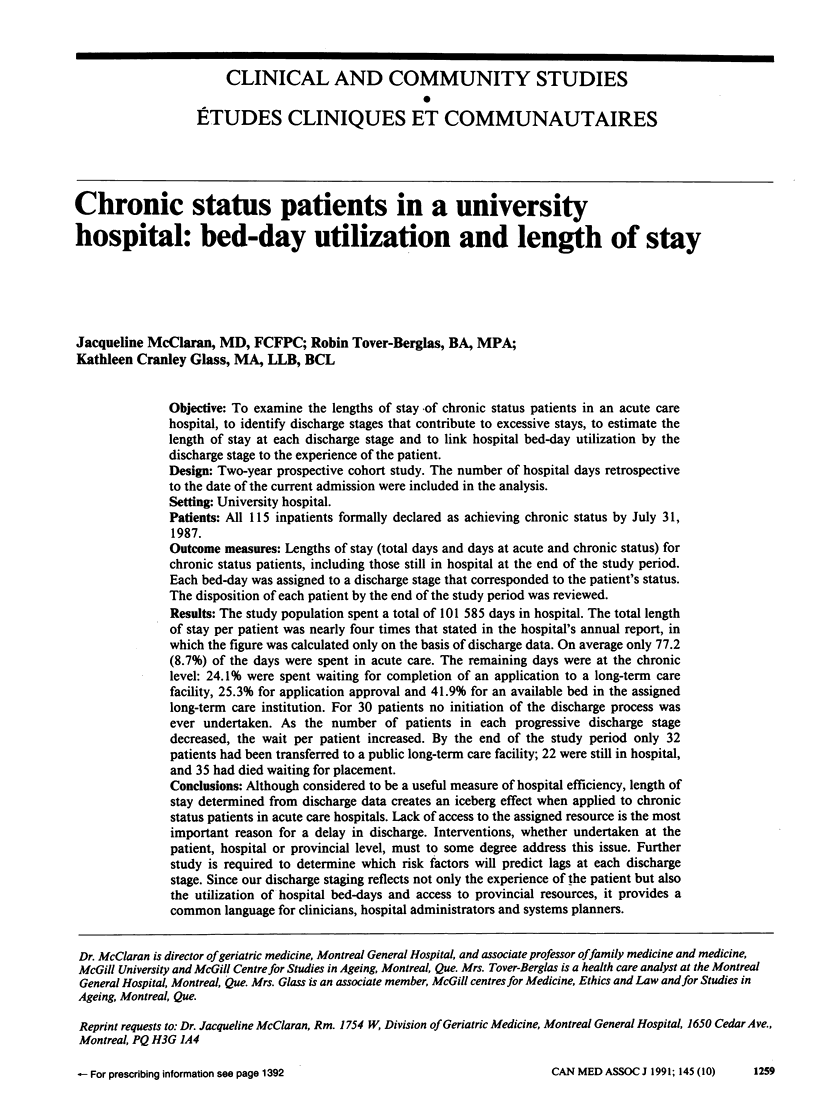
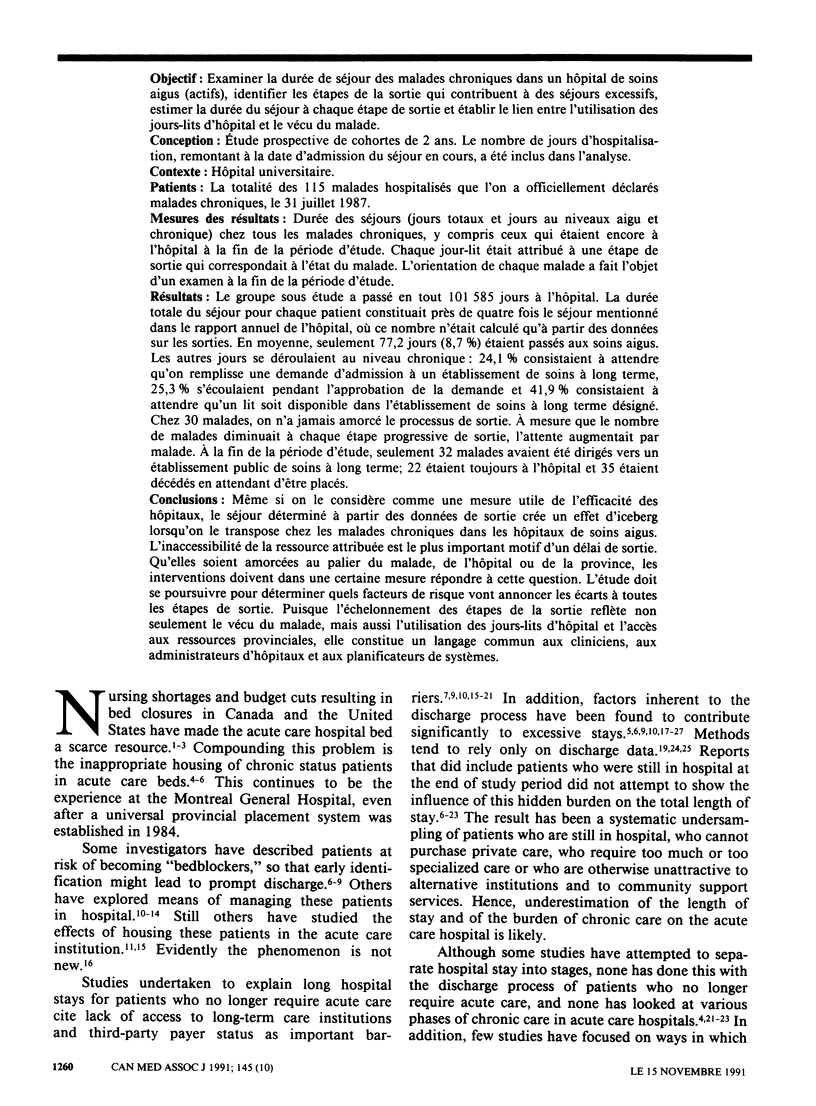
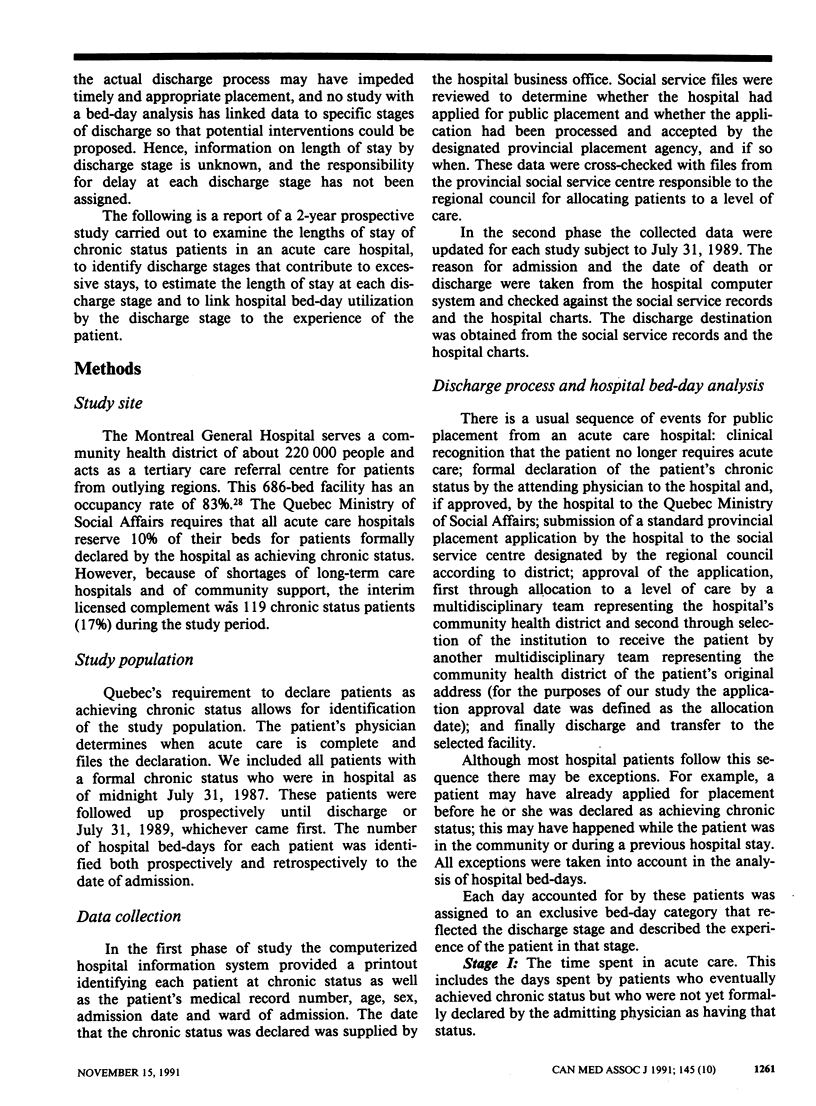
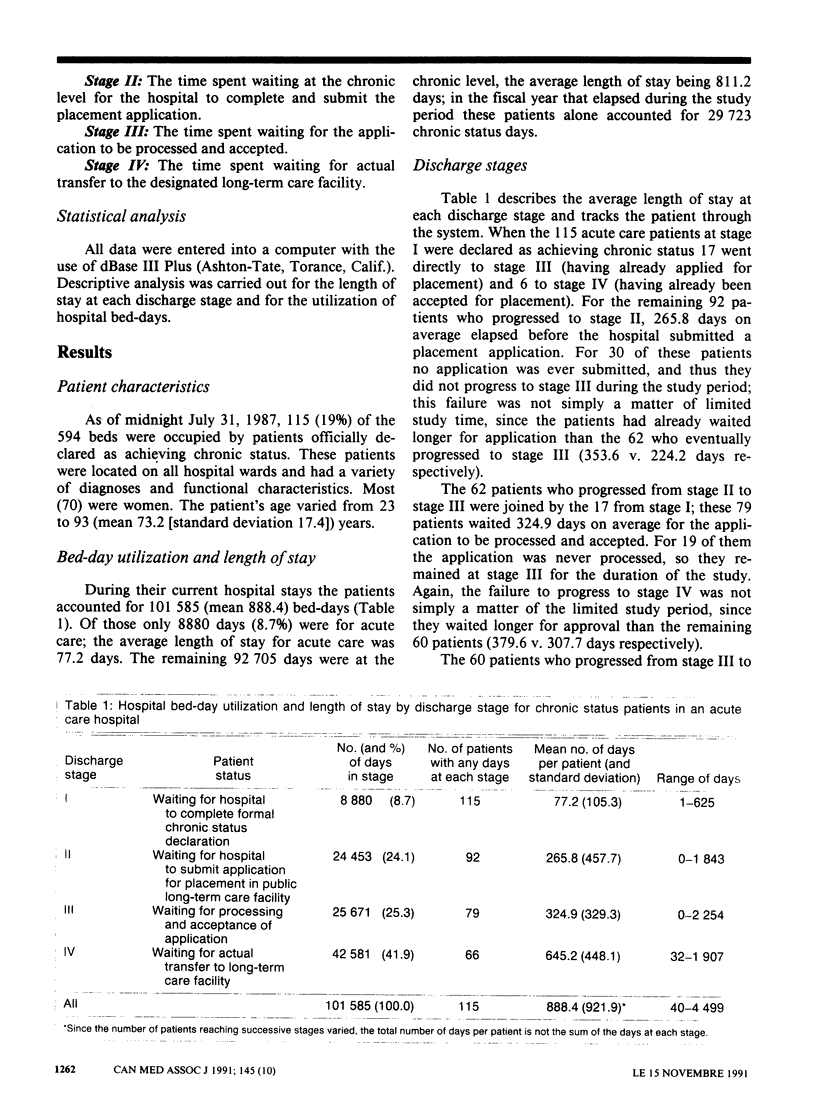
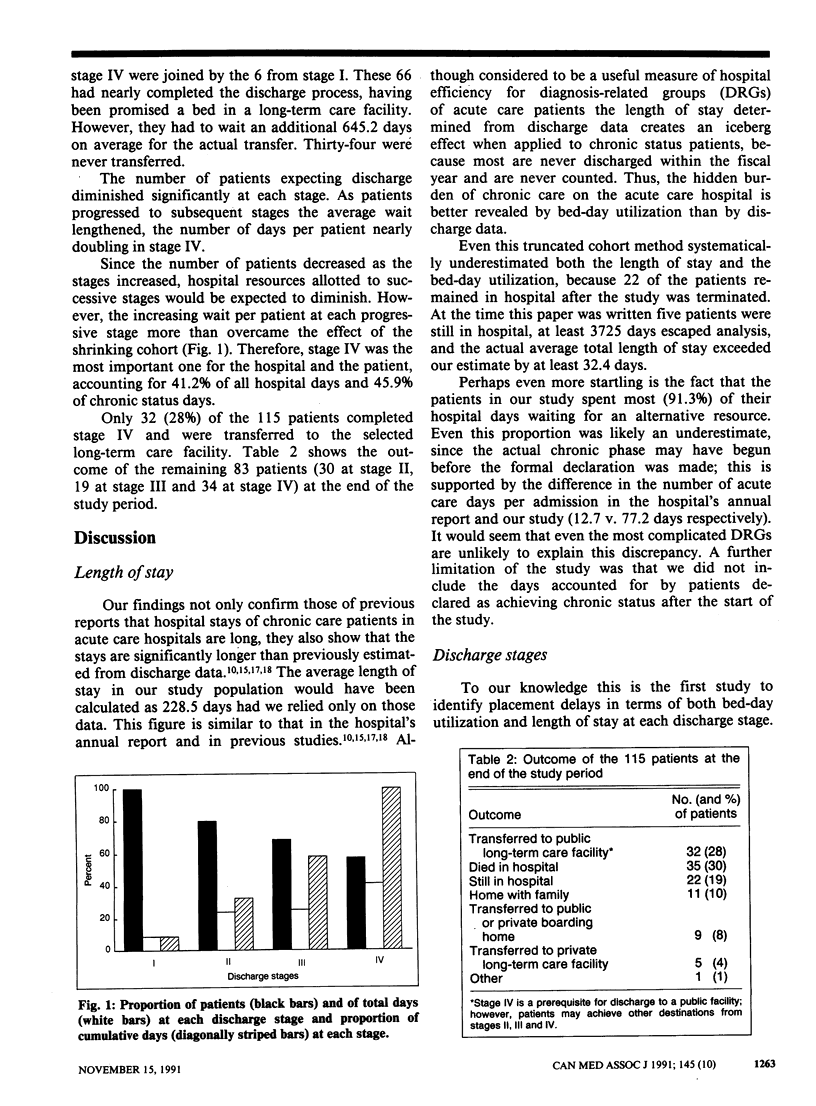
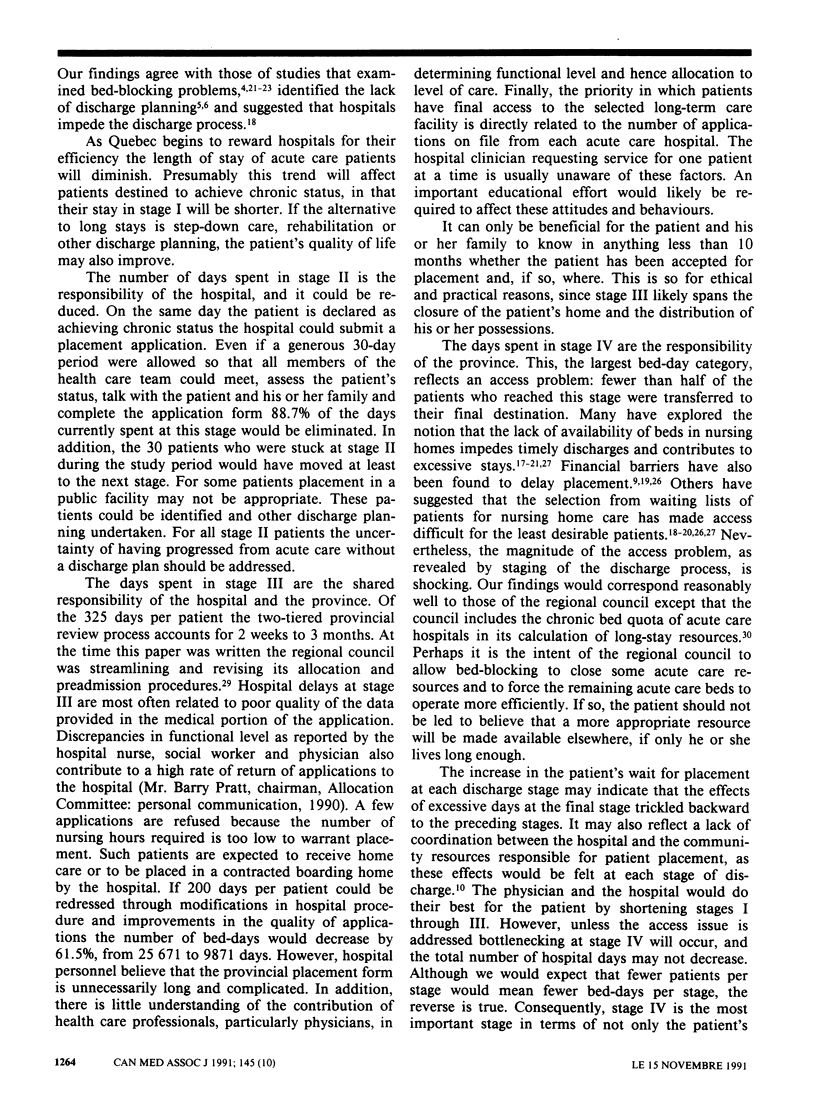

Selected References
These references are in PubMed. This may not be the complete list of references from this article.
- Anderson P., Meara J., Brodhurst S., Attwood S., Timbrell M., Gatherer A. Use of hospital beds: a cohort study of admissions to a provincial teaching hospital. BMJ. 1988 Oct 8;297(6653):910–912. doi: 10.1136/bmj.297.6653.910. [DOI] [PMC free article] [PubMed] [Google Scholar]
- Barker W. H., Williams T. F., Zimmer J. G., Van Buren C., Vincent S. J., Pickrel S. G. Geriatric consultation teams in acute hospitals: impact on back-up of elderly patients. J Am Geriatr Soc. 1985 Jun;33(6):422–428. doi: 10.1111/j.1532-5415.1985.tb07153.x. [DOI] [PubMed] [Google Scholar]
- Beveridge P. Staging acute medical care for the elderly: an analysis of patient admissions. N Z Med J. 1986 Jun 25;99(804):461–464. [PubMed] [Google Scholar]
- Cable E. P., Mayers S. P., Jr Discharge planning effect on length of hospital stay. Arch Phys Med Rehabil. 1983 Feb;64(2):57–60. [PubMed] [Google Scholar]
- Campion E. W., Bang A., May M. I. Why acute-care hospitals must undertake long-term care. N Engl J Med. 1983 Jan 13;308(2):71–75. doi: 10.1056/NEJM198301133080203. [DOI] [PubMed] [Google Scholar]
- Coburn A. F., Fortinsky R. H., McGuire C. A. The impact of Medicaid reimbursement policy on subacute care in hospitals. Med Care. 1989 Jan;27(1):25–33. doi: 10.1097/00005650-198901000-00003. [DOI] [PubMed] [Google Scholar]
- Coid J., Crome P. Bed blocking in Bromley. Br Med J (Clin Res Ed) 1986 May 10;292(6530):1253–1256. doi: 10.1136/bmj.292.6530.1253. [DOI] [PMC free article] [PubMed] [Google Scholar]
- Detsky A. S., O'Rourke K., Naylor C. D., Stacey S. R., Kitchens J. M. Containing Ontario's hospital costs under universal insurance in the 1980s: what was the record? CMAJ. 1990 Mar 15;142(6):565–572. [PMC free article] [PubMed] [Google Scholar]
- Gayton D., Wood-Dauphinee S., de Lorimer M., Tousignant P., Hanley J. Trial of a geriatric consultation team in an acute care hospital. J Am Geriatr Soc. 1987 Aug;35(8):726–736. doi: 10.1111/j.1532-5415.1987.tb06350.x. [DOI] [PubMed] [Google Scholar]
- Gruenberg L. W., Willemain T. R. Hospital discharge queues in Massachusetts. Med Care. 1982 Feb;20(2):188–201. doi: 10.1097/00005650-198202000-00006. [DOI] [PubMed] [Google Scholar]
- Hochstein A. Treating long-stay patients in acute hospital beds: an economic diagnosis. Gerontologist. 1985 Apr;25(2):161–165. doi: 10.1093/geront/25.2.161. [DOI] [PubMed] [Google Scholar]
- Hodkinson I., Hodkinson H. M. The long-stay patient. Gerontology. 1981;27(3):167–172. doi: 10.1159/000212467. [DOI] [PubMed] [Google Scholar]
- Kane R. L., Matthias R., Sampson S. The risk of placement in a nursing home after acute hospitalization. Med Care. 1983 Nov;21(11):1055–1061. doi: 10.1097/00005650-198311000-00002. [DOI] [PubMed] [Google Scholar]
- Kenney G., Holahan J. The nursing home market and hospital discharge delays. Inquiry. 1990 Spring;27(1):73–85. [PubMed] [Google Scholar]
- Lagoe R. J. A community-wide effort to reduce hospital utilization by patients requiring nursing home placement. Gerontologist. 1989 Feb;29(1):67–73. doi: 10.1093/geront/29.1.67. [DOI] [PubMed] [Google Scholar]
- Lewis H., Purdie G. The blocked bed: a prospective study. N Z Med J. 1988 Sep 14;101(853):575–577. [PubMed] [Google Scholar]
- Maguire P. A., Taylor I. C., Stout R. W. Elderly patients in acute medical wards: factors predicting length of stay in hospital. Br Med J (Clin Res Ed) 1986 May 10;292(6530):1251–1253. doi: 10.1136/bmj.292.6530.1251. [DOI] [PMC free article] [PubMed] [Google Scholar]
- McArdle C., Wylie J. C., Alexander W. D. Geriatric patients in an acute medical ward. Br Med J. 1975 Dec 6;4(5996):568–569. doi: 10.1136/bmj.4.5996.568. [DOI] [PMC free article] [PubMed] [Google Scholar]
- Mullner R., Whiteis D. G., McNeil D. Record year for closures in 1987. Hospitals. 1988 Apr 5;62(7):33–36. [PubMed] [Google Scholar]
- Murphy F. W. Blocked beds. Br Med J. 1977 May 28;1(6073):1395–1396. doi: 10.1136/bmj.1.6073.1395. [DOI] [PMC free article] [PubMed] [Google Scholar]
- Pawlson L. G. Hospital length of stay of frail elderly patients. Primary care by general internists versus geriatricians. J Am Geriatr Soc. 1988 Mar;36(3):202–208. doi: 10.1111/j.1532-5415.1988.tb01801.x. [DOI] [PubMed] [Google Scholar]
- Robinson M. L. Economists see closures, cost cuts ahead. Hospitals. 1988 Jan 5;62(1):23–26. [PubMed] [Google Scholar]
- Rubin S. G., Davies G. H. Bed blocking by elderly patients in general-hospital wards. Age Ageing. 1975 Aug;4(3):142–147. doi: 10.1093/ageing/4.3.142. [DOI] [PubMed] [Google Scholar]
- Selker H. P., Beshansky J. R., Pauker S. G., Kassirer J. P. The epidemiology of delays in a teaching hospital. The development and use of a tool that detects unnecessary hospital days. Med Care. 1989 Feb;27(2):112–129. doi: 10.1097/00005650-198902000-00003. [DOI] [PubMed] [Google Scholar]
- Shapiro E., Roos N. P. The geriatric long-stay hospital patient: a Canadian case study. J Health Polit Policy Law. 1981 Spring;6(1):49–61. doi: 10.1215/03616878-6-1-49. [DOI] [PubMed] [Google Scholar]
- Shapiro E., Tate R. B. Is health care use changing? A comparison between physician, hospital, nursing-home, and home-care use of two elderly cohorts. Med Care. 1989 Nov;27(11):1002–1014. [PubMed] [Google Scholar]
- Weissert W. G., Cready C. M. Determinants of hospital-to-nursing home placement delays: a pilot study. Health Serv Res. 1988 Dec;23(5):619–647. [PMC free article] [PubMed] [Google Scholar]
- Wells D. L., Adolphus P. D. Evaluating the care provided to long-stay patients. Dimens Health Serv. 1987 Nov;64(8):20–22. [PubMed] [Google Scholar]


